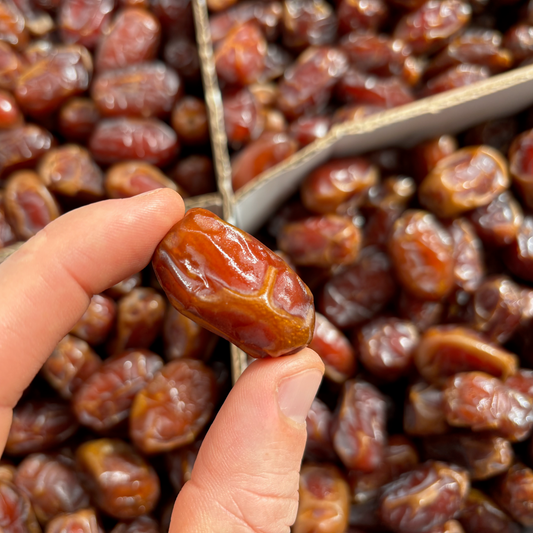fruit notes
By the end of citrus season last year, we decided that the Washington Navels won orange of the year (yes, we made up our own award!). Specifically, because we started the season with Rainwater Ranch’s delicious Washington Navel oranges, grown in a picturesque part of Winters right on the edge of Yolo County. Lauren, Lee, and an all-female farm crew (!!) nurture the seven acre orange orchard that was planted over 50 years ago, alongside fields of cut flowers. Navel oranges are one of those commodity crops we’re programmed to expect everywhere, at any time, our whole lives. The fruit is often flat-flavored with a strange focus on dull sugars. Tasting the freshest Washington Navel oranges at Rainwater was a revelation. Lee explained that the acidity that makes a fresh Navel so dynamic is volatile, dissipating within a matter of days. The flavor is unmatched; the experience is only one you can have in January of the California citrus season. This is the first week of Rainwater's harvest and they’ll continue to get sweeter from here. They have a much smaller crop this season, so don’t miss them! Store on the counter. Grown organically by Rainwater Ranch in Winters.
Last month, I asked Jay if he could wait a couple more weeks to harvest the remaining tamarillo he had left on the plants. A couple weeks turned into a month and here we are in January, with the last flush of the season. On the Central Coast tamarillo is a fall fruit, so it’s unusual to get such a big harvest this time of year. The unusually warm and dry winter in Goleta (and Southern California broadly) means some tropical fall fruit are hanging longer in winter. Jay harvested the tamarillo just ahead of the gusty winds that would have knocked off the ripe fruit. If you’re new to tamarillo, the skin and outer flesh tends to be bitter, so we like to cut them in half and scoop out the seeds and inner flesh. It tastes like guava and melon crossed with savory tomato – the flavors are wildly complex! Store on the counter. Grown organically by Condor Ridge Ranch in Goleta.
Sometime in early December I connected with Nathaniel of Brown Sugar Farm about his Satsuma mandarins. We made plans for him to send us some samples. After some convincing, he agreed to include a few pieces of his Shasta Gold mandarins and Oro Blanco grapefruit too, even though they weren't quite ready yet. He seemed a little confused and a little amused that I wanted underripe fruit to taste. But I'm so happy he agreed because even weeks before they were ready to harvest, you could taste the complexity and the potential in both. Underripe, the mandarins were tangy, juicy, and incredibly flavorful. The grapefruit was a flavor explosion. Now it’s January and we’re tasting the future we imagined. The mandarins are situated on a part of the orchard where they are exposed to more extreme elements, requiring they be harvested a little early, so they are on the smaller side and have very high acid, but these are a happy contrast to the sweet citrus in the box. The Oro Blanco are as sweet as can be. There’s only a few trees of each variety, so lucky us! Store on the counter. Grown sustainably by Brown Sugar Farm in Newcastle.
While most green kiwifruit out there is the Hayward variety, Bryce from Blossom Bluff Orchards decided to plant Mega kiwis about 5 years ago. A local grower recommended the Mega variety because it grew well in their area and produced larger fruit than Haywards. They also produce fewer doubles/fans/butterflies (when it looks like two kiwis merged into one). These have a wonderful texture when firm and are sweeter when a little softer with some give. Store on the counter. Grown organically by Blossom Bluff Orchards in Parlier.
Rainbow Ranch Ojai sits on a 5 acre sloped orchard, lush with Hass avocados, Pixie mandarins, and Kishu mandarins. The orchard floor is soft and squishy – proof of an intensive mulching system. A small flock of sheep can be found grazing on the far side of the orchard, diligently weeding and fertilizing (and occasionally nibbling on fruit). This results in fertile soil and well-fed trees from the nutrient-dense earth. This week, they’re harvesting Kishu mandarins. We saw an early preview of Central Valley Kishus in December, but now it’s prime time. This is when they’re peak delicious! Store on the counter. Grown organically by Rainbow Ranch Ojai in Ojai.
It’s pretty wild that it’s the first week of January and most growers’ Satsuma mandarin crops are done for the season. I’m used to eating Satsumas into February – or at least having the option to! There was SO much rain in the last few weeks that most growers either harvested their whole crop ahead of the wet weather or lost the remaining fruit to rain damage. Laura grows Owari Satsumas in Sebastopol and Nathaniel grows the same in Newcastle (we had these in December!). They both rode out the weather, meaning they had to do extensive removal of damaged fruit from the trees post-rain. With a week of dry weather behind them, they were able to assess what was left. They both had small amounts of Satsumas to harvest for us (for you!). Luckily, the flavor wasn’t compromised, and we’re savoring every piece of these freshly harvested Satsumas. Store on the counter. Grown organically by Laura’s Apples in Sebastopol and grown sustainably by Brown Sugar Farm in Newcastle.





